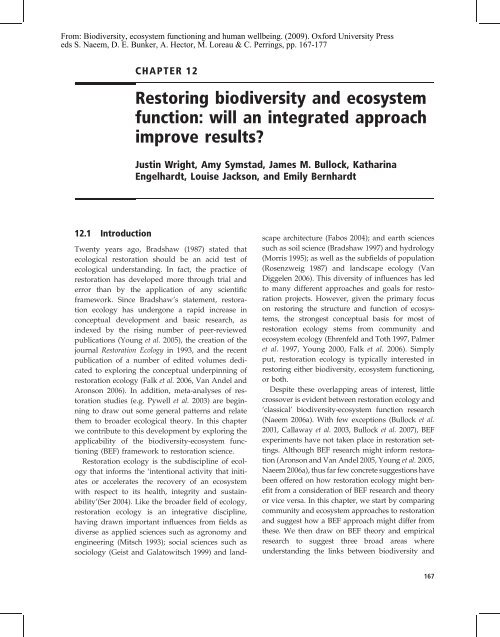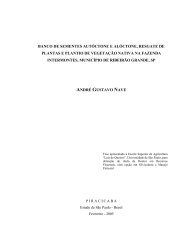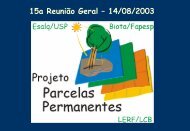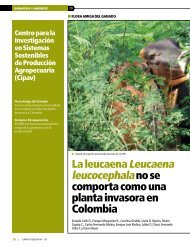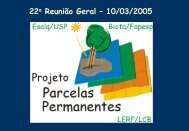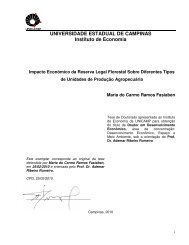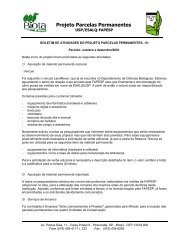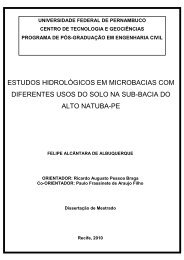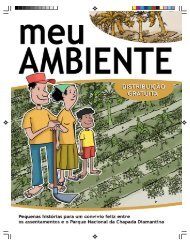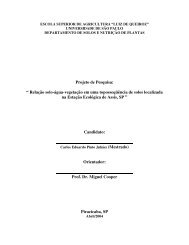Restoring biodiversity and ecosystem function: will an ... - LERF
Restoring biodiversity and ecosystem function: will an ... - LERF
Restoring biodiversity and ecosystem function: will an ... - LERF
You also want an ePaper? Increase the reach of your titles
YUMPU automatically turns print PDFs into web optimized ePapers that Google loves.
From: Biodiversity, <strong>ecosystem</strong> <strong>function</strong>ing <strong><strong>an</strong>d</strong> hum<strong>an</strong> wellbeing. (2009). Oxford University Presseds S. Naeem, D. E. Bunker, A. Hector, M. Loreau & C. Perrings, pp. 167-177CHAPTER 12<strong>Restoring</strong> <strong>biodiversity</strong> <strong><strong>an</strong>d</strong> <strong>ecosystem</strong><strong>function</strong>: <strong>will</strong> <strong>an</strong> integrated approachimprove results?Justin Wright, Amy Symstad, James M. Bullock, KatharinaEngelhardt, Louise Jackson, <strong><strong>an</strong>d</strong> Emily Bernhardt12.1 IntroductionTwenty years ago, Bradshaw (1987) stated thatecological restoration should be <strong>an</strong> acid test ofecological underst<strong><strong>an</strong>d</strong>ing. In fact, the practice ofrestoration has developed more through trial <strong><strong>an</strong>d</strong>error th<strong>an</strong> by the application of <strong>an</strong>y scientificframework. Since Bradshaw’s statement, restorationecology has undergone a rapid increase inconceptual development <strong><strong>an</strong>d</strong> basic research, asindexed by the rising number of peer-reviewedpublications (Young et al. 2005), the creation of thejournal Restoration Ecology in 1993, <strong><strong>an</strong>d</strong> the recentpublication of a number of edited volumes dedicatedto exploring the conceptual underpinning ofrestoration ecology (Falk et al. 2006, V<strong>an</strong> Andel <strong><strong>an</strong>d</strong>Aronson 2006). In addition, meta-<strong>an</strong>alyses of restorationstudies (e.g. Pywell et al. 2003) are beginningto draw out some general patterns <strong><strong>an</strong>d</strong> relatethem to broader ecological theory. In this chapterwe contribute to this development by exploring theapplicability of the <strong>biodiversity</strong>-<strong>ecosystem</strong> <strong>function</strong>ing(BEF) framework to restoration science.Restoration ecology is the subdiscipline of ecologythat informs the ‘intentional activity that initiatesor accelerates the recovery of <strong>an</strong> <strong>ecosystem</strong>with respect to its health, integrity <strong><strong>an</strong>d</strong> sustainability’(Ser2004). Like the broader field of ecology,restoration ecology is <strong>an</strong> integrative discipline,having drawn import<strong>an</strong>t influences from fields asdiverse as applied sciences such as agronomy <strong><strong>an</strong>d</strong>engineering (Mitsch 1993); social sciences such associology (Geist <strong><strong>an</strong>d</strong> Galatowitsch 1999) <strong><strong>an</strong>d</strong> l<strong><strong>an</strong>d</strong>scapearchitecture (Fabos 2004); <strong><strong>an</strong>d</strong> earth sciencessuch as soil science (Bradshaw 1997) <strong><strong>an</strong>d</strong> hydrology(Morris 1995); as well as the subfields of population(Rosenzweig 1987) <strong><strong>an</strong>d</strong> l<strong><strong>an</strong>d</strong>scape ecology (V<strong>an</strong>Diggelen 2006). This diversity of influences has ledto m<strong>an</strong>y different approaches <strong><strong>an</strong>d</strong> goals for restorationprojects. However, given the primary focuson restoring the structure <strong><strong>an</strong>d</strong> <strong>function</strong> of <strong>ecosystem</strong>s,the strongest conceptual basis for most ofrestoration ecology stems from community <strong><strong>an</strong>d</strong><strong>ecosystem</strong> ecology (Ehrenfeld <strong><strong>an</strong>d</strong> Toth 1997, Palmeret al. 1997, Young 2000, Falk et al. 2006). Simplyput, restoration ecology is typically interested inrestoring either <strong>biodiversity</strong>, <strong>ecosystem</strong> <strong>function</strong>ing,or both.Despite these overlapping areas of interest, littlecrossover is evident between restoration ecology <strong><strong>an</strong>d</strong>‘classical’ <strong>biodiversity</strong>-<strong>ecosystem</strong> <strong>function</strong> research(Naeem 2006a). With few exceptions (Bullock et al.2001, Callaway et al. 2003, Bullock et al. 2007), BEFexperiments have not taken place in restoration settings.Although BEF research might inform restoration(Aronson <strong><strong>an</strong>d</strong> V<strong>an</strong> Andel 2005, Young et al. 2005,Naeem 2006a), thus far few concrete suggestions havebeen offered on how restoration ecology might benefitfrom a consideration of BEF research <strong><strong>an</strong>d</strong> theoryor vice versa. In this chapter, we start by comparingcommunity <strong><strong>an</strong>d</strong> <strong>ecosystem</strong> approaches to restoration<strong><strong>an</strong>d</strong> suggest how a BEF approach might differ fromthese. We then draw on BEF theory <strong><strong>an</strong>d</strong> empiricalresearch to suggest three broad areas whereunderst<strong><strong>an</strong>d</strong>ing the links between <strong>biodiversity</strong> <strong><strong>an</strong>d</strong>167
From: Biodiversity, <strong>ecosystem</strong> <strong>function</strong>ing <strong><strong>an</strong>d</strong> hum<strong>an</strong> wellbeing. (2009). Oxford University Presseds S. Naeem, D. E. Bunker, A. Hector, M. Loreau & C. Perrings, pp. 167-177168 BIODIVERSITY, ECOSYSTEM FUNCTIONING, AND HUMAN WELLBEING<strong>ecosystem</strong> <strong>function</strong>ing could have signific<strong>an</strong>timpacts on the success of restoration: ‘classical’ BEFimpacts (i.e. higher diversity leads to improved<strong>function</strong>ing); the effects of <strong>biodiversity</strong> on thestability of <strong>ecosystem</strong> <strong>function</strong>ing; <strong><strong>an</strong>d</strong> the effectsof <strong>biodiversity</strong> on the provisioning of multiple<strong>ecosystem</strong> services.For this chapter, we constrain the scope of whatwe consider to be restoration to m<strong>an</strong>agement activitieswhose primary goal is to improve <strong>ecosystem</strong>services other th<strong>an</strong> provisioning services, althoughimproved provisioning services may result from theactivities. M<strong>an</strong>agement activities whose primarygoal is to improve provisioning services are consideredin Chapter 13, which formally examines the roleof BEF research in m<strong>an</strong>aged <strong>ecosystem</strong>s.12.2 Community, <strong>ecosystem</strong>, <strong><strong>an</strong>d</strong> BEFapproaches to restorationBEF research combines elements from community <strong><strong>an</strong>d</strong><strong>ecosystem</strong> ecology. Consequently, Naeem (2006a)contrasted community <strong><strong>an</strong>d</strong> <strong>ecosystem</strong> approaches torestoration with <strong>an</strong> approach based on the BEF perspective.A community approach largely focuses onthe restoration of the biotic components of <strong>an</strong> <strong>ecosystem</strong>– which species are present, their relative abund<strong>an</strong>ce,<strong><strong>an</strong>d</strong> their interactions (trophic, competitive,facilitative). It is often used when starting fromessentially bare ground, as in tallgrass prairie or haymeadow pl<strong>an</strong>tings in former agricultural fields, <strong><strong>an</strong>d</strong>when the goal of restoration is to enh<strong>an</strong>ce the conservationvalue of a protected l<strong><strong>an</strong>d</strong>scape – restorationfor <strong>biodiversity</strong>’s sake. This approach has evolvedover time from assuming that restoration is essentiallythe speeding up of a linear approach to a specific,predictable, equilibrium state, to accepting thedynamic nature of communities, possible alternativestable states (Bullock et al. 2002, Hobbs 2006), <strong><strong>an</strong>d</strong> theinfluences of disturb<strong>an</strong>ce <strong><strong>an</strong>d</strong> dispersal limitation ondiversity (Pywell et al. 2003, Walker et al. 2004).This evolution may help overcome some of theproblems encountered when using the communityapproach. For example, restoring the target communityis often more difficult th<strong>an</strong> expected, even insystems where community restoration has beenpractised for decades (Kindscher <strong><strong>an</strong>d</strong> Tieszen 1998).Furthermore, restoration of one part of a communityhas not always yielded restoration of the wholecommunity. In both California grassl<strong><strong>an</strong>d</strong>s <strong><strong>an</strong>d</strong>English meadows, pl<strong>an</strong>t composition <strong><strong>an</strong>d</strong> relativeabund<strong>an</strong>ce of species have been restored to resemblethe reference condition, but the soil microbial communityhas remained signific<strong>an</strong>tly different, implyingthat <strong>function</strong>s such as decomposition <strong><strong>an</strong>d</strong> nutrientturnover may not have been restored (Smith et al.2003, Potthoff et al. 2005, Steenwerth et al. 2006, Pywellet al. 2007). Although greater underst<strong><strong>an</strong>d</strong>ing of factorsinfluencing community assembly may overcomesome of these problems, it may not overcome thecommon assumption of the community approach that<strong>function</strong>ing <strong>will</strong> be restored if the community isrestored. This was explicitly studied in two constructedSpartina marshes. In both, vegetation composition,cover, <strong><strong>an</strong>d</strong> biomass of pl<strong>an</strong>ted sites weresimilar to those of natural marshes within 18 monthsof pl<strong>an</strong>ting, but in one case, the height structure failedto meet the needs of the end<strong>an</strong>gered bird for whichthe marshes were constructed (Zedler 1993), <strong><strong>an</strong>d</strong> in<strong>an</strong>other, soil org<strong>an</strong>ic matter <strong><strong>an</strong>d</strong> nutrient accumulation,denitrification rates, <strong><strong>an</strong>d</strong> tidal export of nutrientsrequired much longer to resemble reference levels(Craft et al. 1999).The <strong>ecosystem</strong> approach makes the oppositeassumption, in that a habitat template that restores<strong>ecosystem</strong> processes (e.g. hydrology of a wetl<strong><strong>an</strong>d</strong>)is created, but most or all species are left to colonizeon their own in a process of self-assembly (e.g.Bradshaw 2000). The approach, which is characteristicof m<strong>an</strong>y early restoration efforts (Bradshaw<strong><strong>an</strong>d</strong> Chadwick 1980), may more accurately bedescribed as ‘rehabilitation’ rather th<strong>an</strong> ‘restoration’(Ser 2004). Some examples of this approach includeconstructing mech<strong>an</strong>ical barriers in eroded gulliesin <strong>an</strong> overgrazed r<strong>an</strong>gel<strong><strong>an</strong>d</strong> in order to slow surfacewater flow <strong><strong>an</strong>d</strong> enh<strong>an</strong>ce water percolation into thesoil (King <strong><strong>an</strong>d</strong> Hobbs 2006) <strong><strong>an</strong>d</strong> increasingme<strong><strong>an</strong>d</strong>ering of a stream in order to reduce flashflooding <strong><strong>an</strong>d</strong> increase habitat complexity <strong><strong>an</strong>d</strong> sediment<strong><strong>an</strong>d</strong> nutrient retention (Rosgen 1994). Otheractivities using the <strong>ecosystem</strong> approach includeecological engineering <strong><strong>an</strong>d</strong> reclamation. Ecologicalengineering strives to achieve <strong><strong>an</strong>d</strong> maintain a specific<strong>ecosystem</strong> service within a relatively strictr<strong>an</strong>ge, such as reducing nitrogen in wastewater toregulator-accepted st<strong><strong>an</strong>d</strong>ards via a constructed
From: Biodiversity, <strong>ecosystem</strong> <strong>function</strong>ing <strong><strong>an</strong>d</strong> hum<strong>an</strong> wellbeing. (2009). Oxford University Presseds S. Naeem, D. E. Bunker, A. Hector, M. Loreau & C. Perrings, pp. 167-177RESTORING BIODIVERSITY AND ECOSYSTEM FUNCTION 169wetl<strong><strong>an</strong>d</strong>. In contrast, reclamation strives to make ahighly altered system serve some useful purpose byachieving <strong>an</strong> acceptable level of safety <strong><strong>an</strong>d</strong> aesthetics,such as stabilizing mine tailings withvegetation that c<strong>an</strong> tolerate the harsh conditions butare not necessarily native to the site (Ser 2004). Bothuse ecological processes <strong><strong>an</strong>d</strong> biotic components toachieve their goals, but these goals do not includecreating a system whose <strong>function</strong>ing or compositionresemble a reference <strong>ecosystem</strong>.Although economically attractive, the ‘Field ofDreams’ approach of solely m<strong>an</strong>ipulating the physicalenvironment (‘If you build it, they <strong>will</strong> come’;Hilderbr<strong><strong>an</strong>d</strong> et al. 2005) is risky because dispersalbarriers limit the colonization of desired bioticcomponents <strong><strong>an</strong>d</strong>, even if these c<strong>an</strong> be overcome,interactions with species not yet present (e.g. pollinatorsor mycorrhizae) may be necessary for establishmentor reproduction of import<strong>an</strong>t species.Furthermore, initial seeding with native or exoticspecies that may grow quickly <strong><strong>an</strong>d</strong> provide goodcover c<strong>an</strong> prevent establishment of desired latersuccessional species. For example, in old field sites inEngl<strong><strong>an</strong>d</strong>, sowing of a few native grasses limitedsuccessful colonization by desired species (Pywellet al. 2002). In addition, projects using the <strong>ecosystem</strong>approach with no attention to the composition of thebiotic component may achieve their physio-chemicalgoals, but the narrow focus of these goals may leadto long-term problems. For example, some of today’smost troublesome invasive species were introducedas a rehabilitation measure in over-grazed, droughtstressedr<strong>an</strong>gel<strong><strong>an</strong>d</strong>s (Christi<strong>an</strong> <strong><strong>an</strong>d</strong> Wilson 1999,Clarke et al. 2005, Schussm<strong>an</strong> et al. 2006, Williams<strong><strong>an</strong>d</strong> Crone 2006). Finally, the approach does not takeadv<strong>an</strong>tage of the multiple <strong>function</strong>ality <strong><strong>an</strong>d</strong> resiliencepotentially provided by systems with <strong>an</strong>actively restored biotic community.In contrast, a restoration approach based on BEFtheory <strong><strong>an</strong>d</strong> empirical results stresses the relationshipbetween the biotic community <strong><strong>an</strong>d</strong> <strong>ecosystem</strong><strong>function</strong>ing. Although the BEF perspective does notencompass all of the topics relev<strong>an</strong>t to ecologicalrestoration, it does cover the majority of a moregeneral framework recently proposed for restorationecology (King <strong><strong>an</strong>d</strong> Hobbs 2006). A BEFapproach to restoration is based on the asymptoticrelationship between <strong>biodiversity</strong> <strong><strong>an</strong>d</strong> <strong>ecosystem</strong><strong>function</strong>ing. This relationship is what sets the BEFapproach to restoration apart from the other twoapproaches. Restoration strives to restore <strong>an</strong> <strong>ecosystem</strong>to that relationship by removing <strong>an</strong>thropogenicinputs that maintain high <strong>function</strong>ing but lowdiversity in m<strong>an</strong>aged systems (e.g. fertilizer or pesticides)or by enh<strong>an</strong>cing <strong>function</strong>ing in degradedsystems by adding key sets of species (Naeem2006a). Debate about the applicability of BEF theoryoutside of experimental settings (Huston 1997,(a)Ecosystem <strong>function</strong>M<strong>an</strong>agedDegraded(b)Ecosystem <strong>function</strong>BiodiversityBiodiversityFigure 12.1 The BEF perspective for ecological restoration. (a) The fundamental assumption of the BEF perspective is that <strong>biodiversity</strong> affects <strong>ecosystem</strong><strong>function</strong>, often in the m<strong>an</strong>ner depicted here, where adding diversity when diversity is low has a stronger effect on <strong>ecosystem</strong> <strong>function</strong>ing th<strong>an</strong> adding diversitywhen diversity is high, until the point at which increasing diversity has no effect of <strong>function</strong>ing. Restoration (vertical arrows), in this perspective, is therestoration of this relationship in degraded systems, which have lower <strong>function</strong>ing th<strong>an</strong> expected, or in m<strong>an</strong>aged systems, in which <strong>an</strong>thropogenic inputsproduce <strong>function</strong>ing at a higher level th<strong>an</strong> expected given the system’s diversity. (b) The theoretical realm of possible <strong>ecosystem</strong> <strong>function</strong>ing in relation to<strong>biodiversity</strong>. The hatched area incorporates the assumption, supported by empirical evidence, that it is possible to have greater <strong>function</strong>ing with a low numberof species th<strong>an</strong> with the most diverse system, as well as the assumption that the r<strong>an</strong>ge of variability in <strong>function</strong>ing decreases as <strong>biodiversity</strong> increases. Thelatter assumption has less support from empirical evidence (see text). Figure is adapted from Naeem (2006).
From: Biodiversity, <strong>ecosystem</strong> <strong>function</strong>ing <strong><strong>an</strong>d</strong> hum<strong>an</strong> wellbeing. (2009). Oxford University Presseds S. Naeem, D. E. Bunker, A. Hector, M. Loreau & C. Perrings, pp. 167-177170 BIODIVERSITY, ECOSYSTEM FUNCTIONING, AND HUMAN WELLBEINGBox 12.1 Should the BEF restoration approach apply to all <strong>ecosystem</strong>s?Ecological restoration, like most things ecological, isinherently <strong><strong>an</strong>d</strong> frustratingly context-dependent. Restorationis being carried out in habitats as diverse as streams,rivers, forests, wetl<strong><strong>an</strong>d</strong>s, grassl<strong><strong>an</strong>d</strong>s, estuaries, deserts,<strong><strong>an</strong>d</strong> alpine habitats to achieve <strong>an</strong> equally diverse suite ofgoals. Given the diversity of contexts in which restorationoccurs, it is appropriate to ask whether the BEF approachis relev<strong>an</strong>t to all forms of restoration. We see greatpotential for the BEF perspective to improve the practiceof ecological restoration in m<strong>an</strong>y cases. However, it isimport<strong>an</strong>t to recognize that in systems where abioticstructure serves as the domin<strong>an</strong>t control of <strong>ecosystem</strong>properties, the BEF approach may not be as relev<strong>an</strong>t tosuccessful restoration.Streams <strong><strong>an</strong>d</strong> rivers are <strong>an</strong> instructive case study ofrestoration in <strong>ecosystem</strong>s that are strongly controlled byabiotic forces. River restoration is one of the most extensiveforms of restoration in the USA, with at least $1 billiondollars invested <strong>an</strong>nually (Bernhardt et al. 2005). A growingbody of scientific literature has documented <strong>biodiversity</strong>effects on <strong>ecosystem</strong> <strong>function</strong> in stream <strong>ecosystem</strong>s (e.g.Jonsson <strong><strong>an</strong>d</strong> Malmqvist 2000, Cardinale et al. 2002). Yetbecause the domin<strong>an</strong>t taxa in river <strong>ecosystem</strong>s are easilydispersed, short-lived, <strong><strong>an</strong>d</strong> small it is difficult to apply theseBEF perspectives to river restoration projects. Seedingstreams with the appropriate algae, macroinvertebrates,<strong><strong>an</strong>d</strong> fish is no guar<strong>an</strong>tee that those org<strong>an</strong>isms <strong>will</strong> establish.In terrestrial <strong>ecosystem</strong>s, where vegetation itself providesmuch of the physical structure of the environment on whichother org<strong>an</strong>isms depend, it is easy to see how pl<strong>an</strong>tingdiverse native species assemblages c<strong>an</strong> effectively ‘restore’not only <strong>an</strong> <strong>ecosystem</strong> <strong>function</strong> (¼ productivity) but also keycomponents of <strong>ecosystem</strong> structure (e.g. c<strong>an</strong>opyarchitecture). This is not the case in rivers, where thephysical template is primarily controlled by hydrology <strong><strong>an</strong>d</strong>geomorphology.However, we would argue that a BEF perspective c<strong>an</strong> <strong><strong>an</strong>d</strong>should inform river restoration in two import<strong>an</strong>t respects. First,terrestrial vegetation c<strong>an</strong> play very import<strong>an</strong>t roles in river<strong>ecosystem</strong>s, <strong><strong>an</strong>d</strong> thus BEF approaches c<strong>an</strong> directly informripari<strong>an</strong> m<strong>an</strong>agement aspects of river restoration. The majorityof small stream <strong>ecosystem</strong>s are primarily fueled by leaf litterinputs (Fisher <strong><strong>an</strong>d</strong> Likens 1973), <strong><strong>an</strong>d</strong> higher diversity litterinputs c<strong>an</strong> lead to greater secondary production (Sw<strong>an</strong> <strong><strong>an</strong>d</strong>Palmer 2006). Ripari<strong>an</strong> trees themselves contribute largewood to stream ch<strong>an</strong>nels which c<strong>an</strong> play import<strong>an</strong>t roles asboth habitat <strong><strong>an</strong>d</strong> biogeochemical hotspots in rivers (Wallaceet al. 1995, Valett et al. 2002, Wright <strong><strong>an</strong>d</strong> Flecker 2004,Warren <strong><strong>an</strong>d</strong> Kraft 2006).Second, a BEF perspective should inform the evaluationof river restoration projects. Even when aquatic org<strong>an</strong>ismsc<strong>an</strong>not be directly introduced, monitoring ch<strong>an</strong>ges incommunity composition following restoration activities c<strong>an</strong>provide import<strong>an</strong>t insights into what is <strong><strong>an</strong>d</strong> what is notworking. For example, the absence of shredding <strong>function</strong>alfeeding groups from restored streams relative to referenceconditions may indicate that org<strong>an</strong>ic matter dynamics havenot been effectively restored, the presence of nitrogen-fixingblue–green algae may indicate that phosphorus loads areexcessively high, or the absence of a diverse hyporheicmeiofauna may suggest that groundwater <strong><strong>an</strong>d</strong> surfacewaters have not been effectively reconnected. Whilerestoration practitioners may not be able to actively m<strong>an</strong>agethe diversity of all <strong>ecosystem</strong>s to affect services, recognizingthe links between <strong>biodiversity</strong> <strong><strong>an</strong>d</strong> <strong>ecosystem</strong> <strong>function</strong>ingthat exist even in <strong>ecosystem</strong>s strongly controlled by abioticforces c<strong>an</strong> lead to improved assessment of the success orfailure of restoration projects.Wardle 1999, Naeem 2000, Grace et al. 2007) hashighlighted that restoring a highly diverse communitydoes not necessarily guar<strong>an</strong>tee a high level of<strong>function</strong>ing – environmental factors such as soilfertility <strong><strong>an</strong>d</strong> climate are also crucial determin<strong>an</strong>ts of<strong>ecosystem</strong> <strong>function</strong>ing (Huston <strong><strong>an</strong>d</strong> Mcbride 2002,Naeem 2002b). However, when environmental factorsare held const<strong>an</strong>t, the BEF approach suggeststhat greater <strong>biodiversity</strong> provides a high level of<strong>ecosystem</strong> <strong>function</strong>ing, although achieving the highestlevel of <strong>function</strong>ing does not require the restorationof the entire community (Lehm<strong>an</strong> <strong><strong>an</strong>d</strong> Tilm<strong>an</strong>2000, Naeem 2006a). The rest of this chapter exploresthese implications for restoration in greater detail.12.3 ‘Classical’ BEF implicationsfor restorationSince its earliest inception BEF research has largelybeen focused on testing the hypothesis that the lossof diversity of species (or <strong>function</strong>al groups) leads toch<strong>an</strong>ges in <strong>ecosystem</strong> <strong>function</strong>s such as productivity
From: Biodiversity, <strong>ecosystem</strong> <strong>function</strong>ing <strong><strong>an</strong>d</strong> hum<strong>an</strong> wellbeing. (2009). Oxford University Presseds S. Naeem, D. E. Bunker, A. Hector, M. Loreau & C. Perrings, pp. 167-177RESTORING BIODIVERSITY AND ECOSYSTEM FUNCTION 171Box 12.2 Diversity of grassl<strong><strong>an</strong>d</strong> pl<strong>an</strong>tingsGrassl<strong><strong>an</strong>d</strong> restoration in the central portion of theUSA illustrates the relatively low level of diversity used insome restorations compared to their reference systems<strong><strong>an</strong>d</strong> the implications. Native northern mixed-grass prairie in westernNebraska <strong><strong>an</strong>d</strong> South Dakota has approximately 37–80native pl<strong>an</strong>t species per 0.1 ha (Symstad et al. 2006),whereas the recommended seed mixtures for nativer<strong>an</strong>gel<strong><strong>an</strong>d</strong> pl<strong>an</strong>tings (> 0.1 ha) in this region have amaximum of 13–25 species <strong><strong>an</strong>d</strong> a minimum of fourspecies (http://www.nrcs.usda.gov/technical/efotg/). The federal Conservation Reserve Program (CRP) paysfarmers to pl<strong>an</strong>t or maintain perennial vegetative cover,grassl<strong><strong>an</strong>d</strong> being one allowable type, in areas that wouldotherwise be used for agricultural production. The program,which affects more th<strong>an</strong> 10 million ha of grassl<strong><strong>an</strong>d</strong>nationwide, rewards pl<strong>an</strong>tings that provide <strong>ecosystem</strong>services such as reduced soil erosion, increased wildlifehabitat, water quality protection, soil salinity reduction, <strong><strong>an</strong>d</strong>carbon sequestration (Barbarika 2005). The diversity ofthese pl<strong>an</strong>tings is difficult to track, but typical values are4–10 species. The species pl<strong>an</strong>ted in restorations like these are oftendomin<strong>an</strong>ts (e.g. warm-season bunchgrasses) that drivemajor aspects of <strong>ecosystem</strong> <strong>function</strong>ing (Camill et al. 2004),but low <strong>function</strong>al diversity, particularly the lack of nitrogenfixinglegumes in some pl<strong>an</strong>tings, may limit a restoration’s<strong>function</strong>ing potential (Kindscher <strong><strong>an</strong>d</strong> Tieszen 1998).or nutrient cycling (Naeem et al. 1994, Hooper <strong><strong>an</strong>d</strong>Vitousek 1997, Tilm<strong>an</strong> et al. 1997b). Since these earlystudies, the field of BEF research has flourished, withover 100 published experiments testing this generalhypothesis (Cardinale et al. 2006a). Contentiousdebates have ensued about the proper experimentaldesign or how best to interpret the results of theseexperiments (Garnier et al. 1997, Huston 1997,Wardle et al. 1997a, Thompson et al. 2005, Wrightet al. 2006), <strong><strong>an</strong>d</strong> considerable work still needs to bedone to determine the mech<strong>an</strong>isms that might linkdiversity to <strong>ecosystem</strong> <strong>function</strong>ing. Despite theseuncertainties, several recent meta-<strong>an</strong>alyses havedemonstrated that, on average, <strong>ecosystem</strong> <strong>function</strong>ingdoes increase with increasing numbers of speciesin BEF experiments (Balv<strong>an</strong>era et al. 2006, Cardinaleet al. 2006a). For example, Cardinale <strong><strong>an</strong>d</strong> colleagues(2006a) found that diversity enh<strong>an</strong>ced both pl<strong>an</strong>tproductivity <strong><strong>an</strong>d</strong> nutrient uptake. These <strong>biodiversity</strong>effects c<strong>an</strong> be tied to two <strong>ecosystem</strong> services that areoften the focus of restoration efforts. It should benoted that while the most represented <strong>ecosystem</strong> inthis meta-<strong>an</strong>alysis were grassl<strong><strong>an</strong>d</strong>s, these comprisedonly 34% of the studies, with the rest coming from abroad diversity of other terrestrial <strong><strong>an</strong>d</strong> aquatic <strong>ecosystem</strong>s.Thus there is a growing body of workaddressing BEF questions in other <strong>ecosystem</strong>s suchas streams (Jonsson <strong><strong>an</strong>d</strong> Malmqvist 2000, Cardinaleet al. 2002), wetl<strong><strong>an</strong>d</strong>s (Engelhardt <strong><strong>an</strong>d</strong> Ritchie 2001,Callaway et al. 2003, Sutton-Grier et al. In Review),forests (Bunker et al. 2005, Scherer-Lorenzen et al.2005a), <strong><strong>an</strong>d</strong> marine systems (Duffy et al. 2001, Sol<strong>an</strong>et al. 2004, Fr<strong>an</strong>ce <strong><strong>an</strong>d</strong> Duffy 2006b, Worm et al.2006). For most systems in which restoration is beingconducted, potentially relev<strong>an</strong>t BEF experimentshave been conducted. Applying the findings fromBEF research to restoration practices should be <strong>an</strong>atural extension of existing research. Indeed, astudy that examined the consequences of restoringpl<strong>an</strong>t communities on <strong>ecosystem</strong> <strong>function</strong>ing in aCalifornia estuarine salt marsh demonstrated thatincreasing pl<strong>an</strong>t richness led to higher rates ofnitrogen uptake <strong><strong>an</strong>d</strong> greater above- <strong><strong>an</strong>d</strong> belowgroundbiomass (Callaway et al. 2003). Grassl<strong><strong>an</strong>d</strong><strong><strong>an</strong>d</strong> wetl<strong><strong>an</strong>d</strong> restorations typically start from bareground <strong><strong>an</strong>d</strong> try to recreate natural communitiesthrough the addition of seed. The seed mixes usedare not particularly diverse relative to the natural<strong>ecosystem</strong>s that serve as restoration targets (Box12.2). Thus, m<strong>an</strong>y terrestrial restoration activities areoperating in the region of diversity where varyingspecies richness is most likely to have a signific<strong>an</strong>teffect on <strong>ecosystem</strong> <strong>function</strong>ing, since most <strong>ecosystem</strong><strong>function</strong>s saturate at relatively low levels ofspecies richness (Cardinale et al. 2006a).However, the application of classical BEFresearch to restoration activities may still be limitedgiven our current knowledge. First, while average<strong>ecosystem</strong> <strong>function</strong> has been shown to increasewith increasing diversity (Balv<strong>an</strong>era et al. 2006,Cardinale et al. 2006a), meta-<strong>an</strong>alysis of BEFexperiments has also demonstrated that the highestperforming species in monoculture produces a levelof <strong>ecosystem</strong> <strong>function</strong> that c<strong>an</strong>not be distinguished
From: Biodiversity, <strong>ecosystem</strong> <strong>function</strong>ing <strong><strong>an</strong>d</strong> hum<strong>an</strong> wellbeing. (2009). Oxford University Presseds S. Naeem, D. E. Bunker, A. Hector, M. Loreau & C. Perrings, pp. 167-177172 BIODIVERSITY, ECOSYSTEM FUNCTIONING, AND HUMAN WELLBEINGfrom the level observed in the highest diversitytreatment (Cardinale et al. 2006a). Second, due tothe constraints of experimental design, BEFexperiments do not always include low-diversitypolycultures capable of outperforming the highestdiversity treatment (Chapter 2). Thus, if the goal ofrestoration is to provide a maximum level of <strong>ecosystem</strong>services, arguments could be made forestablishing a high-performing species to rapidlyachieve a high level of <strong>function</strong>ing early in therestoration process. However, because these highperformersare usually domin<strong>an</strong>t species, subordinatespecies may be more difficult to establish afterthe fact, as observed in tallgrass prairie pl<strong>an</strong>tings(Weber 1999), hay meadows (Pywell et al. 2002) <strong><strong>an</strong>d</strong>coastal marshes (Keer <strong><strong>an</strong>d</strong> Zedler 2002). This isparticularly import<strong>an</strong>t because there is some evidencethat the effects of greater diversity on <strong>function</strong>ingtake some time to develop (Tilm<strong>an</strong> et al.2001, Cardinale et al. 2007), <strong><strong>an</strong>d</strong> because thesesubordinate species may contribute to stability of<strong>function</strong>ing.12.4 BEF <strong><strong>an</strong>d</strong> stability of servicesin restorationThe question of whether <strong>biodiversity</strong> contributes tostability (e.g. resist<strong>an</strong>ce to disturb<strong>an</strong>ce, resilienceafter disturb<strong>an</strong>ce, <strong><strong>an</strong>d</strong> moderate r<strong>an</strong>ge of variabilitythrough time) has been a topic in ecology for moreth<strong>an</strong> half a century (e.g. Macarthur 1955, May1972). The recent development of the BEF perspectivehas provided resolution to some aspects ofthis question by suggesting that species that share<strong>function</strong>al effects traits (characteristics that affect<strong>ecosystem</strong> <strong>function</strong>ing in a specific way) often differin their <strong>function</strong>al response traits (characteristicsthat determine how they respond to a specificperturbation). As a result, a relatively low numberof species may provide a certain level of <strong>an</strong> <strong>ecosystem</strong><strong>function</strong> in a const<strong>an</strong>t environment, but ifthese species are adversely affected by a perturbation(e.g. drought, flood, fire, or herbivory), thatlevel of <strong>function</strong>ing <strong>will</strong> only be maintained ifspecies with a similar effect on <strong>function</strong>ing respondpositively to this perturbation. For example, Evineret al. (2006) identified a strong seasonality in theeffects of individual species on N <strong><strong>an</strong>d</strong> P cyclingin northern California grassl<strong><strong>an</strong>d</strong>s. Their resultssuggest that when in mixture, the species’ contributionsto <strong>ecosystem</strong> <strong>function</strong>s would varythroughout the season, providing a mech<strong>an</strong>ism formaintaining these nutrient cycles throughout theseason. In addition, they investigated the relationshipbetween a variety of pl<strong>an</strong>t traits (live tissue<strong><strong>an</strong>d</strong> litter chemistry <strong><strong>an</strong>d</strong> biomass, modification ofbioavailable C <strong><strong>an</strong>d</strong> soil microclimate) <strong><strong>an</strong>d</strong> the <strong>ecosystem</strong><strong>function</strong>s. The influence of individual traitson N mineralization <strong><strong>an</strong>d</strong> nitrification also variedthroughout the growing season, illustrating howresponse traits (to seasonal ch<strong>an</strong>ges in moisture <strong><strong>an</strong>d</strong>temperature) are not necessarily correlated with<strong>function</strong>al effect traits (L<strong><strong>an</strong>d</strong>sberg 1999, Lavorel <strong><strong>an</strong>d</strong>Garnier 2001, Hooper et al. 2002, Naeem <strong><strong>an</strong>d</strong>Wright 2003).Several reviews describe this <strong><strong>an</strong>d</strong> other mech<strong>an</strong>ismsin greater detail <strong><strong>an</strong>d</strong> show the strong theoreticalsupport for the diversity–stability hypothesis(McC<strong>an</strong>n 2000, Cottingham et al. 2001, Loreau et al.2002, Hooper et al. 2005, Chapter 6), <strong><strong>an</strong>d</strong> empiricalsupport for the hypothesis exists from experimentsin systems relev<strong>an</strong>t to ecological restoration. Inplots in which pl<strong>an</strong>t species richness varied becauseof nitrogen m<strong>an</strong>ipulations, aboveground biomasswas more resist<strong>an</strong>t to, <strong><strong>an</strong>d</strong> recovered more fullyfrom, a major drought in more diverse grassl<strong><strong>an</strong>d</strong>plots in central Minnesota, USA (Tilm<strong>an</strong> <strong><strong>an</strong>d</strong>Downing 1994). In the same system, but in plots inwhich pl<strong>an</strong>t species richness was directly m<strong>an</strong>ipulated,temporal stability (measured as temporalme<strong>an</strong>/st<strong><strong>an</strong>d</strong>ard deviation) of aboveground pl<strong>an</strong>tbiomass over ten years increased linearly, fromapproximately 3.5 to 5.8, as pl<strong>an</strong>ted species richnessincreased from one to 16 species, with the diverseplots having lower temporal st<strong><strong>an</strong>d</strong>ard deviationsfor a given me<strong>an</strong> biomass th<strong>an</strong> the monocultures(Tilm<strong>an</strong> et al. 2006b). Despite these encouragingexamples, there are also counter-examples. Morediverse plots had lower resist<strong>an</strong>ce of primary productivityto drought in a Swiss grassl<strong><strong>an</strong>d</strong> experiment(Pfisterer <strong><strong>an</strong>d</strong> Schmid 2002); individualspecies, rather th<strong>an</strong> species richness, affected biomassstability in constructed or natural wetl<strong><strong>an</strong>d</strong>s(Rejm<strong>an</strong>kova et al. 1999, Engelhardt <strong><strong>an</strong>d</strong> Kadlec2001); <strong><strong>an</strong>d</strong> rocky shore intertidal communities withthe greatest diversity were most severely affected
From: Biodiversity, <strong>ecosystem</strong> <strong>function</strong>ing <strong><strong>an</strong>d</strong> hum<strong>an</strong> wellbeing. (2009). Oxford University Presseds S. Naeem, D. E. Bunker, A. Hector, M. Loreau & C. Perrings, pp. 167-177RESTORING BIODIVERSITY AND ECOSYSTEM FUNCTION 173by heat stress (i.e. had low resist<strong>an</strong>ce) but thequickest to recover from the stress (i.e. high resilience)(Allison 2004). A recent meta-<strong>an</strong>alysis of alarge number of studies confirmed this inconsistency– averaged across experiments, more diversesystems were more resist<strong>an</strong>t to nutrient perturbationsor invasions, but diversity had either a neutralor negative effect on resist<strong>an</strong>ce to drought, responseto warming, <strong><strong>an</strong>d</strong> variation in response to long-termenvironmental variability (Balv<strong>an</strong>era et al. 2006).Maintaining <strong>ecosystem</strong> services within a reasonabler<strong>an</strong>ge of variability is <strong>an</strong> import<strong>an</strong>t componentof restoration projects focused on restoring <strong>function</strong>ing.The bal<strong>an</strong>ce of evidence is currently notvery strong that <strong>biodiversity</strong> plays a large role indetermining this variability. However, relativelyfew field-scale studies have investigated this question,<strong><strong>an</strong>d</strong> there is no evidence that diversitystrongly negatively affects stability, particularlyover the long term, so the cost of increasing thediversity of a restoration is likely only the directcost associated with adding that diversity.12.5 Biodiversity <strong><strong>an</strong>d</strong> the restorationof multiple <strong>ecosystem</strong> <strong>function</strong>sRestoration activities are not typically conductedwith the goal of restoring a single <strong>ecosystem</strong> service.Rather, there is <strong>an</strong> implicit underst<strong><strong>an</strong>d</strong>ing that‘healthy’ <strong>ecosystem</strong>s provide a large number ofservices (Duraiappah <strong><strong>an</strong>d</strong> Naeem 2005), <strong><strong>an</strong>d</strong> thatrestoration c<strong>an</strong> serve to increase multiple <strong>ecosystem</strong>services (Nrc 2001, Bernhardt et al. 2005). Forexample, the restoration of Iraq’s Mesopotami<strong>an</strong>marshes has been assessed based on five separate<strong>ecosystem</strong> <strong>function</strong>s: productivity of the domin<strong>an</strong>tpl<strong>an</strong>t Phragmites australis, redox status, hydrologic<strong>function</strong>, salinity, <strong><strong>an</strong>d</strong> bird diversity (Richardson<strong><strong>an</strong>d</strong> Hussain 2006). Similarly, the US NationalResource Council suggested that five major <strong>function</strong>sof wetl<strong><strong>an</strong>d</strong>s need to be considered in theconstruction or restoration of wetl<strong><strong>an</strong>d</strong>s: hydrologic<strong>function</strong>s, water quality <strong>function</strong>s, support ofvegetation, support of fauna, <strong><strong>an</strong>d</strong> soil <strong>function</strong>s(Nrc 2001).This dem<strong><strong>an</strong>d</strong> for multiple <strong>ecosystem</strong> servicesfrom a single restoration may be the strongestargument for incorporating greater <strong>biodiversity</strong>into ecological restorations. As was discussedabove, high diversity plots in BEF experiments donot, on average, signific<strong>an</strong>tly outperform the highestperforming monoculture (Cardinale et al. 2006a).However, what is not clear from this <strong>an</strong>alysis iswhether a single species c<strong>an</strong> maximize the provisioningof multiple <strong>ecosystem</strong> <strong>function</strong>s. Evidencefrom a <strong>biodiversity</strong>, carbon dioxide, <strong><strong>an</strong>d</strong> nitrogenm<strong>an</strong>ipulation experiment in a Minnesota grassl<strong><strong>an</strong>d</strong>context (Reich et al. 2001, Reich et al. 2004) suggeststhat this is not the case. In this experiment, the totalabove- <strong><strong>an</strong>d</strong> belowground biomass produced by aspecies <strong><strong>an</strong>d</strong> the amount of inorg<strong>an</strong>ic nitrate left inthe soils after pl<strong>an</strong>t uptake were strongly correlatedin the first year after pl<strong>an</strong>ting (Fig. 12.2(a)). Such aresult would suggest that a single species might becapable of both fixing high amounts of carbon <strong><strong>an</strong>d</strong>improving water quality by reducing nitrogenexport. However, in subsequent years of theexperiment, this correlation broke down (Fig. 12.2(b,c)), making it more difficult to suggest a singlespecies maximizes both <strong>ecosystem</strong> services. In fact,Hector <strong><strong>an</strong>d</strong> Bagchi (2007) found that maximizingseven <strong>ecosystem</strong> <strong>function</strong>s required between 8 <strong><strong>an</strong>d</strong>16 species at eight grassl<strong><strong>an</strong>d</strong> sites across Europe. Ina recent review, Gamfeldt et al. (2008) found thatmulti<strong>function</strong>al redund<strong>an</strong>cy (i.e. the degree towhich multiple species could sustain multiple<strong>function</strong>s) was generally lower th<strong>an</strong> single-<strong>function</strong>redund<strong>an</strong>cy (i.e. the degree to which multiple speciescould sustain a single <strong>function</strong>).Species effects on <strong>ecosystem</strong> <strong>function</strong>s are <strong>function</strong>sof key morphological <strong><strong>an</strong>d</strong> ecophysiologicaltraits (Engelhardt <strong><strong>an</strong>d</strong> Kadlec 2001, Eviner <strong><strong>an</strong>d</strong>Chapin 2003, Diaz et al. 2004), <strong><strong>an</strong>d</strong> BEF research isincreasingly focused on how particular traits interactto determine the effects of diversity on <strong>ecosystem</strong><strong>function</strong>ing (Eviner <strong><strong>an</strong>d</strong> Chapin 2003, Naeem<strong><strong>an</strong>d</strong> Wright 2003, Sol<strong>an</strong> et al. 2004, Bunker et al.2005). While attempts to determine which traits aremost import<strong>an</strong>t in regulating particular <strong>ecosystem</strong><strong>function</strong>s are still in the early stages, it seems reasonableto assume that different processes might beaffected by different combinations of traits. Giventhis assumption, the extent to which single speciesc<strong>an</strong> maximize multiple <strong>function</strong>s <strong>will</strong> depend onthe extent to which the traits responsible for regulatingthe <strong>ecosystem</strong> <strong>function</strong>s of interest are
From: Biodiversity, <strong>ecosystem</strong> <strong>function</strong>ing <strong><strong>an</strong>d</strong> hum<strong>an</strong> wellbeing. (2009). Oxford University Presseds S. Naeem, D. E. Bunker, A. Hector, M. Loreau & C. Perrings, pp. 167-177174 BIODIVERSITY, ECOSYSTEM FUNCTIONING, AND HUMAN WELLBEINGTotal inorg<strong>an</strong>ic N (0–60 cm)(a) (b) (c)59543 ASTU2100r = 0.78 r = 0.18 LUPEr = 0.158LUPE47AMCALECAPEVI653ANCYLECAPOPRASTUPEVIANCY42AMCAANGEKOCRBOGRPEVILECAAMCABRINSONUSCSC POPRKOCR SORH SOREADRE ANOE POPR3ANCY KOCR BOIP AGREASTUACMIAGRE1ACMIBOGRSORISCSO2ACMIPOGRANOESONUSONUSONUSORI0200 400 600 800 1000 1200 1400 0 200 400 600 800 1000 1200 1400 1600 0 200 400 600 800 1000 12001Total biomass (g/m 2 )LUPEAQ: Please notethat the mergedlabels are notclear. Kindlyadvise.Figure 12.2 Relationship between two <strong>ecosystem</strong> <strong>function</strong>s, total above- <strong><strong>an</strong>d</strong> belowground biomass (a surrogate for carbon storage) <strong><strong>an</strong>d</strong> total extractablesoil inorg<strong>an</strong>ic nitrogen (a surrogate for nitrogen removal from groundwater) from monocultures of different species in control plots (ambient levels ofatmospheric CO 2 <strong><strong>an</strong>d</strong> nitrogen) of the BioCON BEF experiment from (a) 1999, (b) 2000, <strong><strong>an</strong>d</strong> (c) 2001. Species codes of the monocultures are: Achilleamillefolium ACMI; Agropyron repens AGRE; Amorpha c<strong>an</strong>escens AMCA; Andropogon gerardi ANGE; Anemone cylindrical ANCY; Asclepias tuberose ASTU;Bouteloua gracilis BOGR; Bromus inermis BRIN; Koeleria cristata KOCR; Lespedeza capitata LECA; Lupinus perennis LUPE; Petalostemum villosum PEVI; Poapratensis POPR; Schizachyrium scoparium SCSC; Solidago rigida SORI; Sorghastrum nut<strong>an</strong>s SONU. Note that the scale ch<strong>an</strong>ges on the axes between years.correlated. Several recent large-scale <strong>an</strong>alyses havefound signific<strong>an</strong>t correlations between severalimport<strong>an</strong>t traits in pl<strong>an</strong>ts (Diaz et al. 2004, Wrightet al. 2004, Reich et al. 2006) <strong><strong>an</strong>d</strong> <strong>an</strong>imals (Brown et al.2004). These correlations yield suites of traits (e.g.those contributing to rapid acquisition of resourcesvs. those that contribute to conservation of resourcesin well-protected tissues in pl<strong>an</strong>ts) that typicallyoccur together in org<strong>an</strong>isms. The uniformity of thesesuites across broad taxonomic groups <strong><strong>an</strong>d</strong> geographicalgradients argue for the existence of fundamentaltradeoffs in org<strong>an</strong>ismal development <strong><strong>an</strong>d</strong>life history. Whether or not these tradeoffs hold upwithin local species pools, where selection mightpush for diversification along trait axes (Grime 2006,Ackerly <strong><strong>an</strong>d</strong> Cornwell 2007), <strong><strong>an</strong>d</strong> for the traitsactually responsible for <strong>ecosystem</strong> <strong>function</strong>s ofinterest in restoration (Eviner 2004), remains <strong>an</strong> open<strong><strong>an</strong>d</strong> import<strong>an</strong>t question.12.6 The economics of BEF in restorationFor BEF research to be useful for ecological restoration,<strong>ecosystem</strong> <strong>function</strong>s must be related to the<strong>ecosystem</strong> services desired as the outcome of restoration.A key issue in performing this tr<strong>an</strong>slationis that BEF research often does not assign a specificworth to a level of <strong>ecosystem</strong> <strong>function</strong>ing otherth<strong>an</strong> a vague ‘more is better’ for primary productivityor nutrient capture (Srivastava <strong><strong>an</strong>d</strong> Vellend2005). In contrast, in restoration, the relative worthof various levels of <strong>ecosystem</strong> services must beassessed <strong><strong>an</strong>d</strong> agreed to by m<strong>an</strong>y stakeholders when<strong>an</strong>y but the simplest restoration project is commenced(Fig. 12.3). Provisioning services, such asforage production, c<strong>an</strong> be easily converted intocurrency value (Bullock et al. 2007). However, whileWorm et al. (2006) showed dramatic increases intourism-related revenue following the closure offisheries in marine protected areas, which theyattribute to increases in diversity, this conversion isnot as easy for other types of <strong>ecosystem</strong> servicesresulting from ecological restorations. For example,results from BEF research might predict grams ofcarbon fixed per square metre, grams of nitrogenremoved through denitrification, <strong><strong>an</strong>d</strong> grams of thegreenhouse gasses N 2 O <strong><strong>an</strong>d</strong> meth<strong>an</strong>e produced bydifferent combinations of species used in a wetl<strong><strong>an</strong>d</strong>restoration project. Until markets exist that allowtr<strong>an</strong>slation of these <strong>ecosystem</strong> processes into acommon currency, determining which mixture ofspecies maximizes benefits while minimizing costsis, at best, just a guess. The growth of carbontrading markets (Bonnie et al. 2002) <strong><strong>an</strong>d</strong> early
From: Biodiversity, <strong>ecosystem</strong> <strong>function</strong>ing <strong><strong>an</strong>d</strong> hum<strong>an</strong> wellbeing. (2009). Oxford University Presseds S. Naeem, D. E. Bunker, A. Hector, M. Loreau & C. Perrings, pp. 167-177RESTORING BIODIVERSITY AND ECOSYSTEM FUNCTION 175Carbon storageTotal benefit ?Monocultureattempts at nitrogen trading schemes such as theEPA’s Water Quality Trading Program (active inareas of 10 states in the USA) suggests that economicvaluations of at least some of the nonprovisioning<strong>ecosystem</strong> services provided by restored<strong>ecosystem</strong>s are being developed. An even more difficulttask is deriving a common currency for servicessuch as protecting higher trophic levels or maintaininghydrologic services, although tools for evaluatingdifferent options in the face of such uncertainties doexist (Lynam et al. 2007).12.7 RecommendationsPolycultureNitrogen removalFigure 12.3 Hypothetical restoration scenario involving two <strong>ecosystem</strong>services: carbon storage (circles) <strong><strong>an</strong>d</strong> nitrogen removal (squares). M<strong>an</strong>agerscould choose between pl<strong>an</strong>ting a monoculture of species 1 (filled symbols)that provides high levels of carbon storage but low levels of nitrogenremoval, a monoculture of species 2 (open symbols) that provides lowlevels of carbon storage but high levels of nitrogen removal, or a mixture ofboth species that provides intermediate levels of both carbon storage <strong><strong>an</strong>d</strong>nitrogen removal. The total benefit of the <strong>ecosystem</strong> services provided bythese different m<strong>an</strong>agement choices (straight lines) is unknown <strong><strong>an</strong>d</strong> <strong>will</strong>depend both on the shape of the relationship between diversity <strong><strong>an</strong>d</strong> thesetwo <strong>function</strong>s <strong><strong>an</strong>d</strong> on the relative economic weight placed on the twoservices.We argue that underst<strong><strong>an</strong>d</strong>ing the relationshipbetween <strong>biodiversity</strong> <strong><strong>an</strong>d</strong> <strong>ecosystem</strong> <strong>function</strong>ing isimport<strong>an</strong>t in enh<strong>an</strong>cing restoration success in m<strong>an</strong>y<strong>ecosystem</strong>s <strong><strong>an</strong>d</strong> that restoration activities c<strong>an</strong> serveas powerful tools for exploring some of the centralBEF questions. However, information exch<strong>an</strong>gebetween the scientific community <strong><strong>an</strong>d</strong> restorationpractitioners is too little <strong><strong>an</strong>d</strong> too slow for BEFresearch to be relev<strong>an</strong>t in adaptive m<strong>an</strong>agement ofdegraded <strong>ecosystem</strong>s. Ecologists are recognizingthat performing policy-relev<strong>an</strong>t science involvesmore th<strong>an</strong> simply publishing in high-profile??academic journals (Palmer et al. 2004). This point isreinforced by a recent survey of stream restorationpractitioners that showed that less th<strong>an</strong> 1 per centof over 300 restoration projects had specificallybeen informed by results published in scientificjournals (Bernhardt et al. 2007). So what c<strong>an</strong> bedone to improve the situation?For scientists, we make a few suggestions. First,continue basic BEF research, but keep in mind theinformation needed by restoration practitioners.Deeper underst<strong><strong>an</strong>d</strong>ing of how <strong>function</strong>al traitsacting alone <strong><strong>an</strong>d</strong> in combination affect <strong>ecosystem</strong><strong>function</strong>s that are related to <strong>ecosystem</strong> services isparticularly import<strong>an</strong>t. Although general relationshipsbetween diversity <strong><strong>an</strong>d</strong> <strong>function</strong>ing explainwhy the restoration of <strong>biodiversity</strong> is import<strong>an</strong>t forrestoring <strong>ecosystem</strong> <strong>function</strong>ing, restoration practitionersultimately need to know which specificspecies combinations to restore <strong><strong>an</strong>d</strong> have confidencein the outcome of restoration projects.However, BEF theory, while expl<strong>an</strong>atory, is not yetpredictive (Hooper et al. 2005) <strong><strong>an</strong>d</strong> is therefore notyet ready to be embraced by the m<strong>an</strong>agementcommunity. Furthermore, experimental perturbationsin BEF experiments, <strong><strong>an</strong>d</strong> monitoring ofexperiments over long time periods in which theenvironment fluctuates naturally, <strong>will</strong> help resolvewhat role <strong>biodiversity</strong> plays in stabilizing <strong>ecosystem</strong>services. However, because species <strong><strong>an</strong>d</strong> communitiesrespond to environmental fluctuations inseemingly idiosyncratic ways, investigations thattie these two themes together, by seeking patternsin traits that determine species’ responses to environmentalvariations, <strong>will</strong> yield the most relev<strong>an</strong>tinformation for restoration.BEF research focusing on microbial diversity isparticularly crucial because m<strong>an</strong>y of the mostcritical <strong>ecosystem</strong> services are underpinned bymicrobial processes (e.g. the nutrient tr<strong>an</strong>sformationsthat improve water quality). Our underst<strong><strong>an</strong>d</strong>ingof both how pl<strong>an</strong>t <strong><strong>an</strong>d</strong> <strong>an</strong>imal diversityaffect microbial community structure <strong><strong>an</strong>d</strong> howmicrobial diversity directly affects <strong>ecosystem</strong><strong>function</strong>ing in real systems is relatively weak(Fierer et al. 2007, Jackson et al. 2007). To date therehas been little focus on the import<strong>an</strong>ce of restoringmicrobial communities or how to go about doingso (Hasselw<strong><strong>an</strong>d</strong>ter 1997). Restoration of the
From: Biodiversity, <strong>ecosystem</strong> <strong>function</strong>ing <strong><strong>an</strong>d</strong> hum<strong>an</strong> wellbeing. (2009). Oxford University Presseds S. Naeem, D. E. Bunker, A. Hector, M. Loreau & C. Perrings, pp. 167-177176 BIODIVERSITY, ECOSYSTEM FUNCTIONING, AND HUMAN WELLBEINGmicrobial community in meadows were notachieved by a simple soil microbe addition technique(Pywell et al. 2007), but experiments haveshown that microbial community composition isrelated to both the diversity of the restored pl<strong>an</strong>tcommunities <strong><strong>an</strong>d</strong> to particular ‘facilitating’ pl<strong>an</strong>tspecies (Smith et al. 2003, Bardgett et al. 2006). Adeeper underst<strong><strong>an</strong>d</strong>ing of the controls <strong><strong>an</strong>d</strong> consequencesof microbial diversity is <strong>an</strong> area whereBEF research is well-poised to make import<strong>an</strong>tcontributions to restoration ecology.Another aspect of diversity that may be critical torestoration success, but has been not been as extensivelystudied in BEF research, is the import<strong>an</strong>ce ofgenetic diversity. M<strong>an</strong>y <strong>ecosystem</strong>s, including m<strong>an</strong>ythat are import<strong>an</strong>t targets for restoration, are dominatedby a single species that controls <strong>ecosystem</strong><strong>function</strong>, e.g. gi<strong>an</strong>t kelp in kelp forests, Ponderosapine in m<strong>an</strong>y forests of the Western US, seagrassessuch as Zostera marina in shallow estuarine systems,<strong><strong>an</strong>d</strong> Spartina in intertidal zones. A growing body ofwork is showing that genetic diversity within a speciesc<strong>an</strong> be <strong>an</strong> import<strong>an</strong>t regulator of <strong>ecosystem</strong><strong>function</strong> (Hughes et al. 2008). Work on Zostera, <strong>an</strong>import<strong>an</strong>t species in estuarine restoration, showedthat clonal diversity measurably affects <strong>ecosystem</strong>processes or the stability of those processes (Hughes<strong><strong>an</strong>d</strong> Stachowicz 2004, Reusch et al. 2005). Williams(2001) demonstrated that reduced genetic variationin Zostera used in restoration efforts resulted indecreased population growth <strong><strong>an</strong>d</strong> individual fitness.For both cottonwood (Populus fremontii x augustifolia)(Schweitzer et al. 2005a) <strong><strong>an</strong>d</strong> apsen (Populus tremuloides)(Madritchet al. 2006), genotypic richness c<strong>an</strong>affect decomposition rates <strong><strong>an</strong>d</strong> nutrient cycling.Clonal diversity of Solidago altissima were shown toaffect, not only primary productivity, but the diversityof higher trophic levels (Crutsinger et al. 2006).Given these compelling examples, research on theconsequences of genetic diversity of species commonlyused in restoration is likely to yield benefitsboth to basic science <strong><strong>an</strong>d</strong> restoration.Third, to make the results of <strong>an</strong>y BEF researchapplicable to practitioners, the connection from <strong>biodiversity</strong>to <strong>function</strong> to services needs to be stronger.For example, although the positive effects of pl<strong>an</strong>tdiversity on above- <strong><strong>an</strong>d</strong> belowground biomass productionin grassl<strong><strong>an</strong>d</strong> experiments have been vaguelyrelated to forage production, carbon storage, <strong><strong>an</strong>d</strong> soilerosion, little attention has been paid to whether thenutrient content of the biomass is sufficient for thepurported foragers (see Bullock et al. 2007 for <strong>an</strong>exception) <strong><strong>an</strong>d</strong> direct measurements of soil movementor long-term C sequestration are rare (thoughmore common in wetl<strong><strong>an</strong>d</strong> studies). Given the need ofm<strong>an</strong>y restorations to restore multiple services, thisconnection needs to be made simult<strong>an</strong>eously formultiple <strong>function</strong>s <strong><strong>an</strong>d</strong> their related services.Addressing these issues is already one of the centralthrusts of the next generation of BEF research (Naeem<strong><strong>an</strong>d</strong> Wright 2003) <strong><strong>an</strong>d</strong> should not require signific<strong>an</strong>tch<strong>an</strong>ges to how we proceed with our science beyondthe <strong>function</strong>s <strong><strong>an</strong>d</strong> properties measured in typical BEFexperiments.Fourth, evaluate the relev<strong>an</strong>ce of experiments toreal-world conditions. There is some conflictbetween the typical BEF experiment, which iscarefully designed to disent<strong>an</strong>gle the effects ofindividual species, <strong>function</strong>al traits, <strong><strong>an</strong>d</strong> diversityper se on the <strong>function</strong>s measured, <strong><strong>an</strong>d</strong> restorationprojects, which are concerned with achieving adesired result with available materials <strong><strong>an</strong>d</strong> limitedfin<strong>an</strong>cial resources. Restoration practitioners maylook at the high density of expensive species (m<strong>an</strong>yforbs, for example) pl<strong>an</strong>ted in some BEF experiments<strong><strong>an</strong>d</strong> question the applicability of the resultsto their work: does the diversity effect require thisrelatively high input of normally subordinate orrare species? They might also question the relativelycontrolled situations of the field experiments:would the results be the same if vertebrate herbivoreswere not excluded from the plots, or if colonizingspecies were not removed? Finally, apractitioner would never think of restoring a Spartinaalterniflora marsh without Spartina alterniflora,but m<strong>an</strong>y BEF studies include treatments <strong>an</strong>alogousto this situation. Of greater interest to a restorationpractitioner would be the question of how strongthe diversity effect is when the only portion ofdiversity m<strong>an</strong>ipulated is the subordinate <strong><strong>an</strong>d</strong> rarespecies. These subordinate species may be essentialto certain key <strong>function</strong>s which define the success orfailure of the restoration. For example, grassl<strong><strong>an</strong>d</strong>restoration in the UK to meet national BiodiversityAction Pl<strong>an</strong> targets requires the presence of foodpl<strong>an</strong>ts of certain declining butterflies <strong><strong>an</strong>d</strong> other
From: Biodiversity, <strong>ecosystem</strong> <strong>function</strong>ing <strong><strong>an</strong>d</strong> hum<strong>an</strong> wellbeing. (2009). Oxford University Presseds S. Naeem, D. E. Bunker, A. Hector, M. Loreau & C. Perrings, pp. 167-177RESTORING BIODIVERSITY AND ECOSYSTEM FUNCTION 177insects, but these pl<strong>an</strong>ts are often uncommon <strong><strong>an</strong>d</strong>particularly difficult to establish (Pywell et al. 2003).Thus, BEF researchers seeking to provide <strong>an</strong>swersfor restoration practitioners <strong><strong>an</strong>d</strong> other naturalresource m<strong>an</strong>agers need to ensure that they designtheir experiments with these issues in mind.Concurrently, restoration practitioners <strong><strong>an</strong>d</strong> ecologistsc<strong>an</strong> potentially contribute signific<strong>an</strong>tly tostrengthen BEF research. For them, we stress theutmost import<strong>an</strong>ce of monitoring <strong><strong>an</strong>d</strong> reportingshort- <strong><strong>an</strong>d</strong> long-term effects of various restorationprojects <strong><strong>an</strong>d</strong> practices. In the US, the federal governmentpays private l<strong><strong>an</strong>d</strong> owners millions of dollarseach year to pl<strong>an</strong>t <strong><strong>an</strong>d</strong> maintain perennial grassl<strong><strong>an</strong>d</strong>sthrough the Conservation Reserve Program. A l<strong><strong>an</strong>d</strong>owner’sproposal is more likely to be funded if s/hepl<strong>an</strong>ts a higher diversity of species (Usda 2006), butfollow-up on the establishment success <strong><strong>an</strong>d</strong> environmentalbenefits of individual pl<strong>an</strong>tings is rare, <strong><strong>an</strong>d</strong>only recently have comparisons among the <strong>ecosystem</strong>services provided by pl<strong>an</strong>tings of different diversitylevels been explored. In the USA, a major source offunding for stream <strong><strong>an</strong>d</strong> wetl<strong><strong>an</strong>d</strong> restoration is associatedwith mitigation of wetl<strong><strong>an</strong>d</strong> losses under theCle<strong>an</strong> Water Act (Nrc 2001). Guidelines for successfulrestoration vary from state to state, but typicallyinvolve recommended species lists <strong><strong>an</strong>d</strong> some assessmentof total vegetation cover. Some states are currentlydeveloping improved vegetation assessmentsthat include repeated measurements of the cover of allpl<strong>an</strong>ted <strong><strong>an</strong>d</strong> unpl<strong>an</strong>ted species. In the case of NorthCarolina, this improved monitoring scheme has beendeveloped in coordination with the Carolina VegetationSurvey to ensure that monitoring data c<strong>an</strong> bedirectly incorporated into <strong>an</strong> existing vegetationdatabase that is actively being used in ecologicalresearch (Lee et al. 2007). As a member of the Europe<strong>an</strong>Union, the UK Government pays out m<strong>an</strong>y millionsof pounds a year in funding restoration on farml<strong><strong>an</strong>d</strong>under the Environmental Stewardship scheme(http://www.defra.gov.uk/erdp/schemes/es/).This scheme exemplifies the <strong>biodiversity</strong> or <strong>ecosystem</strong>service dichotomy. Certain activities aim to restore aservice, such as sowing field margins with a mix ofpl<strong>an</strong>ts designed to provide pollen <strong><strong>an</strong>d</strong> nectar for bees<strong><strong>an</strong>d</strong> butterflies or to provide winter seed for birds. Inthese cases the pl<strong>an</strong>t mixture does not resemble <strong>an</strong>yseen in (semi-) natural systems <strong><strong>an</strong>d</strong> often containsnon-natives. Other activities are focused on <strong>biodiversity</strong>,such as the sowing of specific pl<strong>an</strong>t mixturesinto bare arable l<strong><strong>an</strong>d</strong> or species-poor grassl<strong><strong>an</strong>d</strong>s torestore particular target species-rich grassl<strong><strong>an</strong>d</strong>s. Certainauthors have criticized the effectiveness ofEurope<strong>an</strong> agri-environment schemes (e.g. Kleijn et al.2006). This is partly because these authors have confusedthe aims of different activities (e.g. expecting thebird-seed mixtures to restore rare arable weed communities),but also because monitoring of outcomeshas been poor. The limited monitoring (e.g. Critchleyet al. 2004, Feeh<strong>an</strong> et al. 2005) of vegetation has shownsome success, but suggests that better targeting <strong><strong>an</strong>d</strong>more precise methods are required. This is leading topl<strong>an</strong>ning for more extensive <strong><strong>an</strong>d</strong> repeated monitoringprograms <strong><strong>an</strong>d</strong> consideration of how <strong>biodiversity</strong> <strong><strong>an</strong>d</strong><strong>ecosystem</strong> service aims might be integrated (e.g. forsoil conservation).Clearly, BEF research still has m<strong>an</strong>y avenues toexplore before the majority of questions surroundingthe relationship between <strong>biodiversity</strong> <strong><strong>an</strong>d</strong> <strong>ecosystem</strong><strong>function</strong>ing are <strong>an</strong>swered. Just as clearly,restoration ecology still has a long way to go beforethe results of reconstructing <strong>an</strong> <strong>ecosystem</strong> c<strong>an</strong> be aspredictable as the construction of a bridge or even aspace station. Although not all restoration projectsare suited to <strong>an</strong>swering basic science questionsregarding the relationship between <strong>biodiversity</strong> <strong><strong>an</strong>d</strong><strong>ecosystem</strong> <strong>function</strong>ing, they are crucial to makingBEF science applicable to real-world situations.Direct partnerships between researchers testing BEFconcepts <strong><strong>an</strong>d</strong> restoration practitioners are crucial forecological restoration live up to its potential as <strong>an</strong>acid test for BEF ecology.


